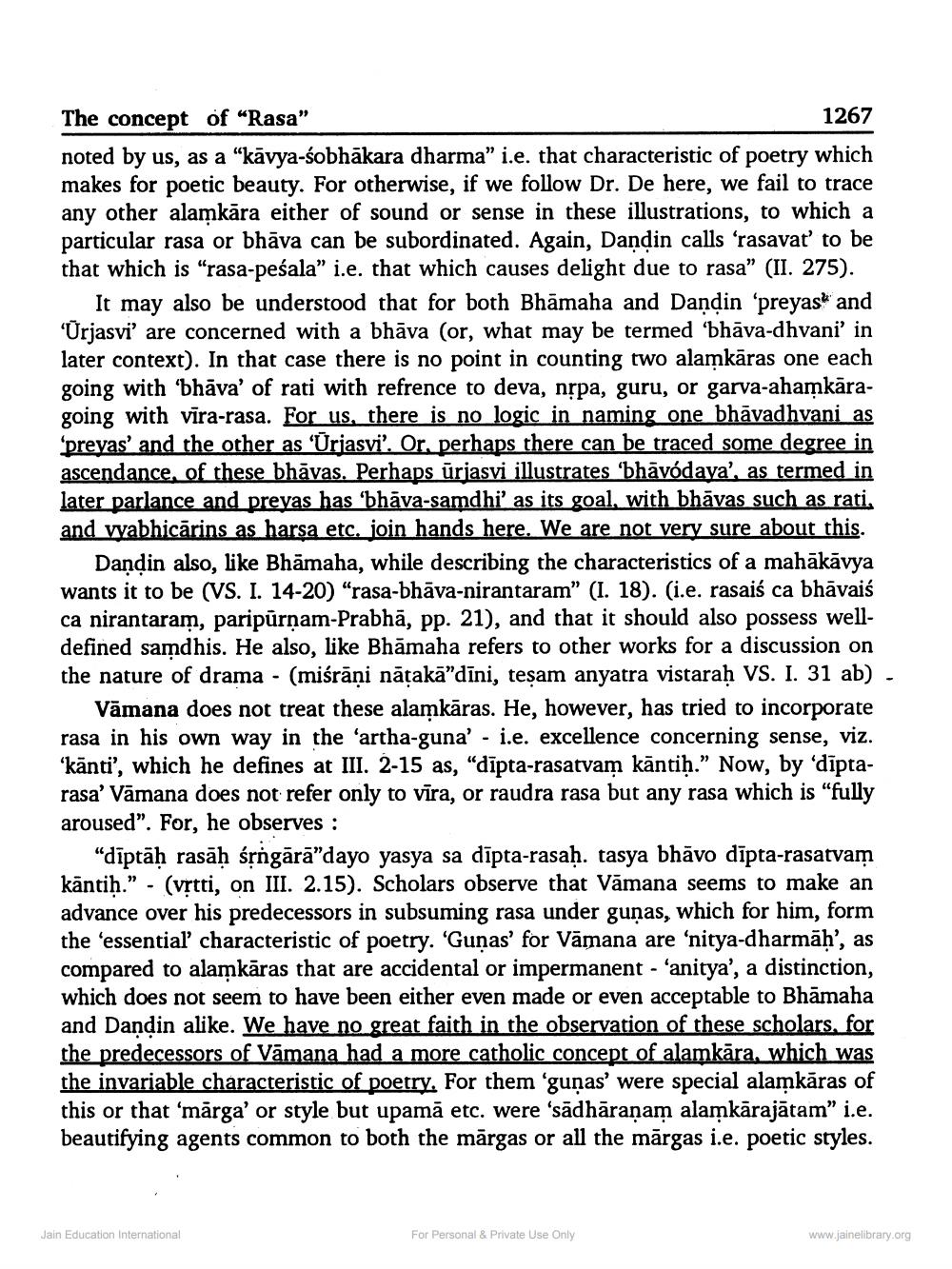________________
The concept of "Rasa"
1267 noted by us, as a "kāvya-sobhākara dharma” i.e. that characteristic of poetry which makes for poetic beauty. For otherwise, if we follow Dr. De here, we fail to trace any other alamkāra either of sound or sense in these illustrations, to which a particular rasa or bhāva can be subordinated. Again, Dandin calls 'rasavat to be that which is “rasa-peśala” i.e. that which causes delight due to rasa” (II. 275).
It may also be understood that for both Bhāmaha and Dandin 'preyask and 'Urjasvi' are concerned with a bhāva (or, what may be termed 'bhāva-dhvani' in later context). In that case there is no point in counting two alamkāras one each going with 'bhāva' of rati with refrence to deva, nộpa, guru, or garva-ahamkāragoing with vira-rasa. For us, there is no logic in naming one bhāvadhvani as 'prevas' and the other as 'ūriasvi'. Or perhaps there can be traced some degree in ascendance of these bhāvas. Perhaps ūriasvi illustrates 'bhāvódava', as termed in later parlance and prevas has 'bhāva-samdhi' as its goal, with bhāvas such as rati. and wabhicārins as harsa etc. join hands here. We are not very sure about this.
Dandin also, like Bhämaha, while describing the characteristics of a mahākāvya wants it to be (VS. I. 14-20) “rasa-bhāva-nirantaram" (I. 18). (i.e. rasaiś ca bhāvaiś ca nirantaram, paripurnam-Prabhā, pp. 21), and that it should also possess welldefined samdhis. He also, like Bhāmaha refers to other works for a discussion on the nature of drama - (mišrāni nātakā"dīni, tesam anyatra vistarah VS. I. 31 ab) -
Vāmana does not treat these alamkāras. He, however, has tried to incorporate rasa in his own way in the fartha-guna' - i.e. excellence concerning sense, viz. 'kānti', which he defines at III. 2-15 as, "dīpta-rasatvam kāntih.” Now, by 'dīptarasa' Vāmana does not refer only to vīra, or raudra rasa but any rasa which is "fully aroused”. For, he observes :
"dīptāḥ rasāḥ śrngārā"dayo yasya sa dīpta-rasah. tasya bhāvo dīpta-rasatvam kāntih." - (vrtti, on III. 2.15). Scholars observe that Vāmana seems to make an advance over his predecessors in subsuming rasa under guņas, which for him, form the 'essential characteristic of poetry. 'Gunas' for Vāmana are 'nitya-dharmāh, as compared to alamkāras that are accidental or impermanent - 'anitya', a distinction, which does not seem to have been either even made or even acceptable to Bhāmaha and Dandin alike. We have no great faith in the observation of these scholars, for the predecessors of Vāmana had a more catholic concept of alamkāra, which was the invariable characteristic of poetry. For them 'gunas' were special alamkāras of this or that 'märga' or style but upamā etc. were 'sādhāraṇam alamkārajātam” i.e. beautifying agents common to both the mārgas or all the mārgas i.e. poetic styles.
Jain Education International
For Personal & Private Use Only
www.jainelibrary.org




